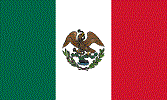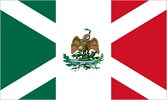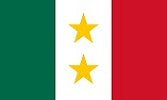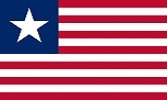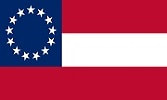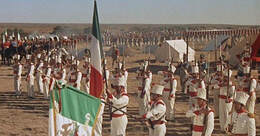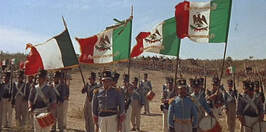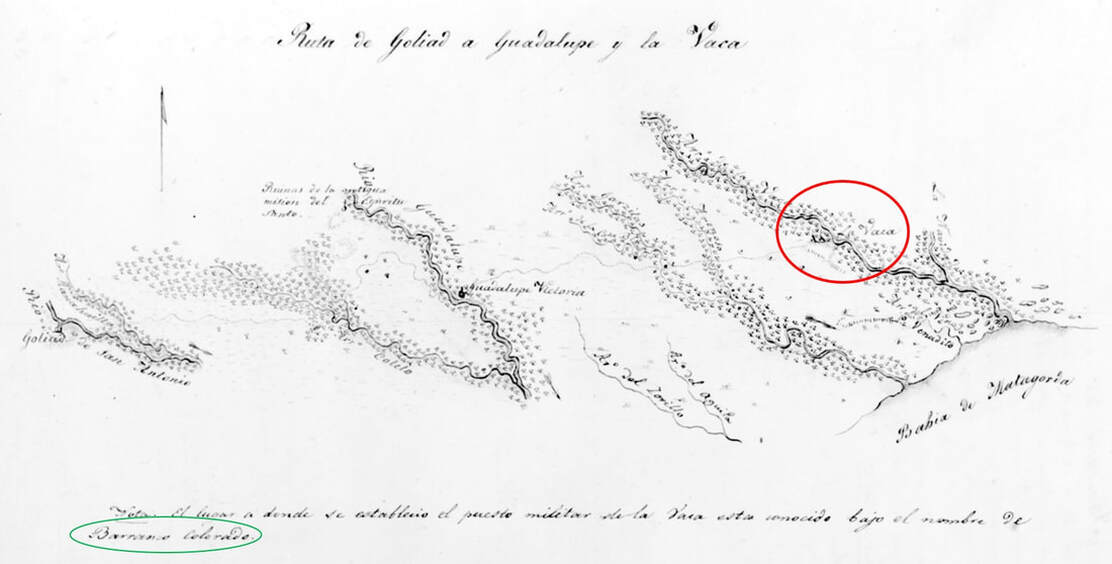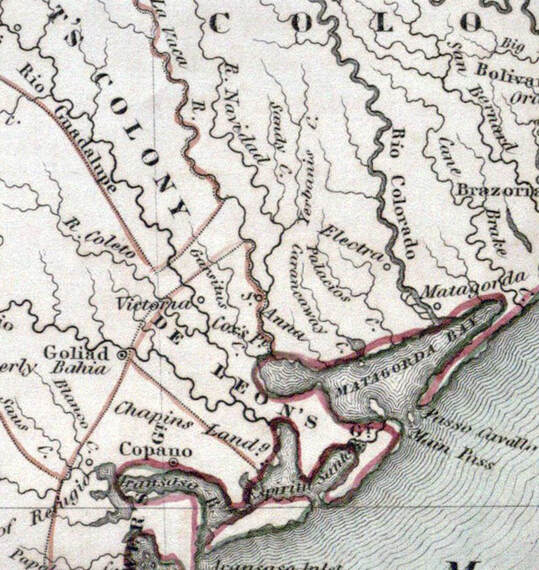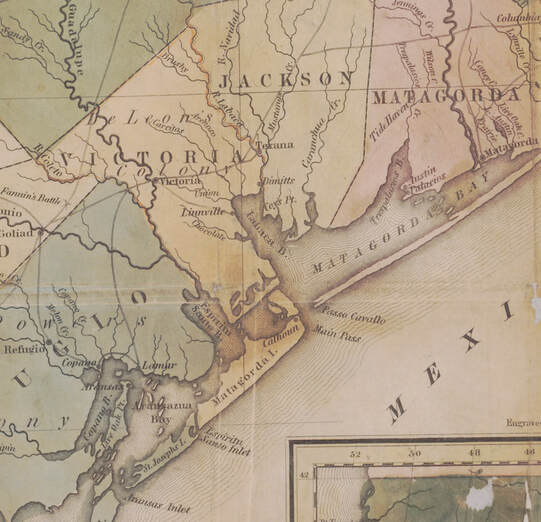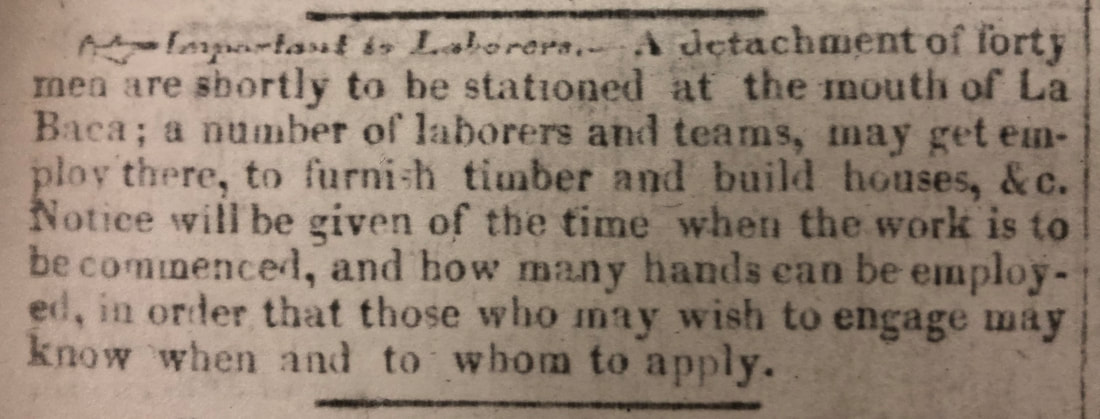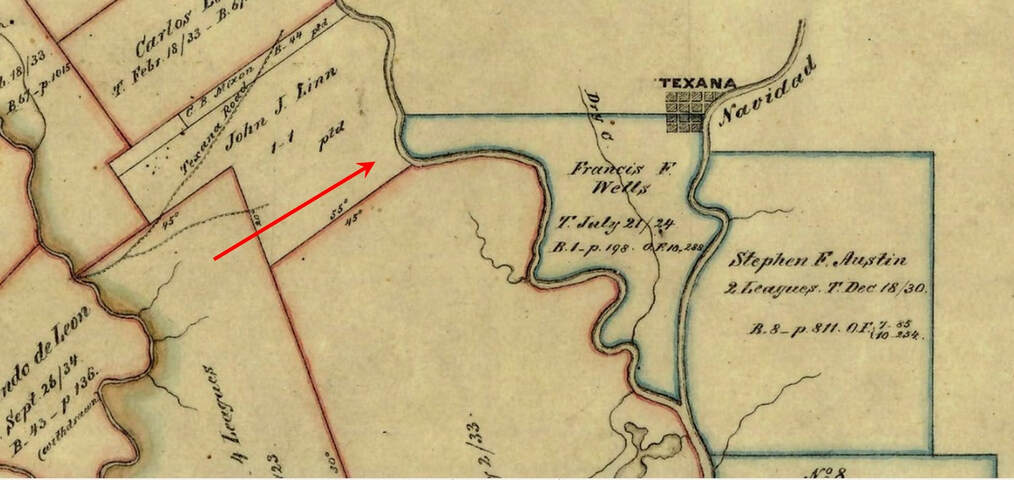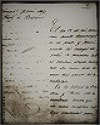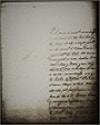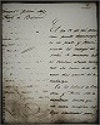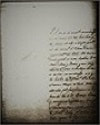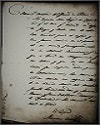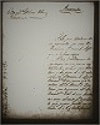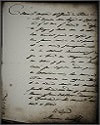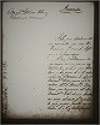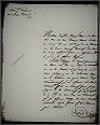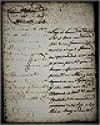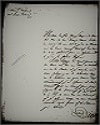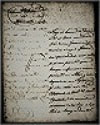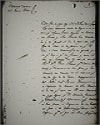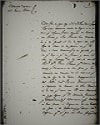|
Barranco Colorado Comandancia Militar Del Establecimiento De La Vaca (Detachment on the lower Lavaca River) Just before the Battle Of Velasco, reinforcements were sought from a Mexican military post on the Lavaca River commanded by Aniceto Arteaga, and this post seemed especially well informed about happenings in Brazoria and Velasco, since travelers and deserters passed that way. |
This cantonment of the Mexican Army existed from mid-1830 to mid-1832, and its location is shown on a chart thought to have been drawn by Jean Louis Berlandier in 1834 (below). He had accompanied Terán’s boundary expedition to Texas in 1828, and passed through this area in 1829 on an excursion from Bexar by land to La Bahia, Copano, and then by sea to New Orleans, returning the same way. He returned to La Bahia (Goliad) in 1834, probably drawing this map of his route while traveling in that vicinity. The chart shows "La Vaca" (red oval) on "Arroyo de La Vaca", which the caption says was named "Barranco Colorado" (green oval).
In his book "Reminiscences of Fifty Years in Texas", John Linn wrote these words: "Colonel Ugartechea, the commandant of the fort (Velasco) evinced a disposition and bearing by no means palatable to the colonists. He was a man of sagacity and foresaw the coming storm, and was possessed of a sufficient knowledge of the art of war to know that he could not uphold with a bare handful of men the supremacy of Mexico in the midst of an exasperated American colony. Consequently, he despatched couriers to Victoria, and possibly to other posts, for reinforcements. Captain Artiaga, who commanded on the Lavaca River, positively refused to send his men to Velasco, saying he was not under the command of Colonel Ugartechea. Captain Artiaga sought advice from some of the leading citizens of Victoria in regard to the Velasco affair. The citizens consulted were Sylvester de Leon, Fernando de Leon, John McHenry, and the author of these reminiscences. Artiaga stated that he was opposed to the policy being pursued by General Santa Anna ; that he was not acquainted with the topography of the country and especially was he ignorant of that in the vicinity of the Brazos, etc. The citizens of Austin's colony were excited at the 'Bradburn outrage,' as the imprisonment of Travis, Jack, and others was very justly styled, and Ugartechea's position in holding out against the demands of the excited multitude was anything but encouraging. Finally Captain Artiaga concluded that it would be dangerous for his men to march through the 'Caney Swamp'."
|
At an earlier point in the book, Linn also wrote about this post: “... During this year (1830) General Teran sent two hundred soldiers to establish a military post on the Lavaca River. This addition to our scant population gave a decided impetus to trade. I engaged to supply the troops with all articles suitable to their wants. .........
..... There were in Victoria and on the Lavaca River above two hundred soldiers, who had been sent by the orders of General Teran in 1831. He had intended building a fort on the Lavaca; the definite position had not been decided upon, but the manufacture of brick had been commenced at a place called ‘El Banco Colorado,’ or ‘The Red Bank’ , on the west bank of the Lavaca and about three miles west of Texana. The works were under the control of Don Manuel Choval (Rafael Chowell?, Comisario de Lavaca), a gentlemen of birth and education, commissioned by General Teran. ... The immediate commander of the troops was Captain Artiaga, also a perfect gentleman and an old officer, who had served throughout the Mexican Revolution. ... After the surrender of Velasco (late Jun-1832) and the intrigues of Santa Anna had been developed, and after the death of General Teran (3-Jul-1832), who committed suicide by falling upon his sword, Commissioner Choval resigned, and Captain Artiaga informed General Mexia that he wished to be relieved of the responsibilities of his position, as he did not favor the movements of Santa Anna. ......" A similar geologic formation on the Navidad gave the name to Red Bluff, Texas, now about where Palmetto Bend Dam impounds the Navidad River to form Lake Texana - only a cemetery and former school house remains, just south of the dam. |
|
".... An order arrived directing the removal of the whole army, together with the workmen at the brick-kiln, some thirty or forty in number. These latter were from various parts of Mexico, who had been convicted of offenses against the laws and were known here as ‘the chain-gang’. .... Lieutenant-Colonel Villasana arrived in a schooner in the bay to transport the troops to Matamoros, but had no funds with which to pay for provisions and other expenses. He had, however, authority to draw on the custom-house at Matamoros. ... As the ‘Lavaca command’ was indebted to me for supplies, Captain Artiaga called on me and stated that he was ordered to abandon the proposed fort; that he needed supplies, and that Villasana would draw on the Matamoros custom-house for the same. I knew their impecunious condition and the venture of accepting Villasana’s check in payment, but so anxious were we all to get rid of the military that I determined to supply their necessities and run the risk of ever receiving pay, in order to contribute to the peace and prosperity of our country. All this was consummated. I supplied all their wants, and received of Villasana an order on the custom-house at Matamoros for some EIGHT HUNDRED and odd dollars. I sent the draft to a friend in Matamoros for collection. He was offered payment upon the basis of a ruinous discount which he did not deem at all equitable or just, and the proposed liquidation was rejected. .... But I have failed to receive one cent of that sum up to the present day. After the departure of the above-mentioned troops Texas enjoyed a period of peaceful quiet, absolutely free from the presence of Mexican soldiery, until the year 1835.” Unlike other forts built to implement the Law of 6-Apr-1830 (Fort Anahuac, Fort Terán, Fort Tenoxtitlán, Fort Lipantitlán, and Fort Velasco), such a fort or post is not well known in modern references. |
|
A review of the Béxar Archives reveals over 100 letters to/from/about Aniceto Arteaga or the Lavaca post from 31-May-1830 to 12-Jul-1832 at locations shown initially as “Guadalupe” and then for two years at “Barranco Colorado”, perhaps indicating that (like Linn mentioned) some soldiers stayed first in Guadalupe Victoria (modern Victoria, Texas) and some (perhaps convict soldiers and their guards) were posted on the Lavaca River making bricks to build a fort, after which the post was occupied by all. It seems odd that they were there for perhaps 2 years and no substantial fort was left (as at Anahuac), especially when compared with Fort Velasco which was occupied for only about two months, and had significantly less correspondence. Perhaps, like Fort Velasco, much of the post was made of wooden structures, which decayed in the years afterward.
|
Vicente Filisola in "Memorias para la historia de la guerra de Tejas" Vol. 1 (English translation p. 139) has this passage:
“The town of San Felipe de Austin is the capital and focal point for the colonists of Texas. General Terán has ordered the occupation of this and El Paso del Caballo, Lavaca or Barranco Colorado, Fort Velasco, Galveston, Anáhuac, Fort Terán, Harrisburg, Nacogdoches and Tenoxtitlán and some others.”
As a high school student, Mindora Bagby wrote a prize-winning essay in 1924 for the Caldwell Prize in Local History, published in the University of Texas Bulletin, which mentioned in part “.... As late as 1832 the Mexican Government kept soldiers in a fort that stood on a high bluff on the west side of the Lavaca River. The traces of the fort and the old mission have almost disappeared and there are very few people living in the county at present who can locate the sites where they stood. At Dimmett's Landing on the Lavaca (Dimmitt’s Landing was on the west bank at the mouth of the river), the Texans, in the revolution with Mexico, received many of their supplies and ammunition. About thirty-five years ago some of this land was put in cultivation and old cannon balls, bayonets, sabers, and muskets were plowed up.”
Ira Thomas Taylor published the book "The Cavalcade of Jackson County" in 1938, with a small chapter entitled “Last Camp Site of Mexican Army in Jackson County”. It says in part “As late as 1831 and 1832 a Mexican army of some two hundred men with some thirty or forty convicts was stationed within the present boundaries of Jackson County, in the southeast corner of the John Linn Survey and on the west side of the Lavaca River near the present home of Charley Jones. It had been proposed by the Mexican Government to build a fort undoubtedly intended to overawe and if necessary to exterminate the citizens who had come from the United States in good faith to make their homes in Jackson County. ... This military camp under the command of Captain Artiaga at a point called “El Banco Colorado” or the “Red Bank,” was an army camp as well as a penal colony for convicts from old Mexico. The convicts were engaged in making brick and shipping them by boat to ports in old Mexico. Brick were actually manufactured there at that early date, and a number of such brick have been dug up from that brickyard and are now souvenirs of many of our citizens. ... This army was removed and the camp abandoned by order of the Mexican Government in July, 1832. ... All that remains of this old camp site on the high river bank is part of the remains of the old brick kiln.” The John J. Linn survey is shown on the map below, with a red arrow indicating the approximate location of Barranco Colorado, also showing an old road segment which appears headed toward it.
“The town of San Felipe de Austin is the capital and focal point for the colonists of Texas. General Terán has ordered the occupation of this and El Paso del Caballo, Lavaca or Barranco Colorado, Fort Velasco, Galveston, Anáhuac, Fort Terán, Harrisburg, Nacogdoches and Tenoxtitlán and some others.”
As a high school student, Mindora Bagby wrote a prize-winning essay in 1924 for the Caldwell Prize in Local History, published in the University of Texas Bulletin, which mentioned in part “.... As late as 1832 the Mexican Government kept soldiers in a fort that stood on a high bluff on the west side of the Lavaca River. The traces of the fort and the old mission have almost disappeared and there are very few people living in the county at present who can locate the sites where they stood. At Dimmett's Landing on the Lavaca (Dimmitt’s Landing was on the west bank at the mouth of the river), the Texans, in the revolution with Mexico, received many of their supplies and ammunition. About thirty-five years ago some of this land was put in cultivation and old cannon balls, bayonets, sabers, and muskets were plowed up.”
Ira Thomas Taylor published the book "The Cavalcade of Jackson County" in 1938, with a small chapter entitled “Last Camp Site of Mexican Army in Jackson County”. It says in part “As late as 1831 and 1832 a Mexican army of some two hundred men with some thirty or forty convicts was stationed within the present boundaries of Jackson County, in the southeast corner of the John Linn Survey and on the west side of the Lavaca River near the present home of Charley Jones. It had been proposed by the Mexican Government to build a fort undoubtedly intended to overawe and if necessary to exterminate the citizens who had come from the United States in good faith to make their homes in Jackson County. ... This military camp under the command of Captain Artiaga at a point called “El Banco Colorado” or the “Red Bank,” was an army camp as well as a penal colony for convicts from old Mexico. The convicts were engaged in making brick and shipping them by boat to ports in old Mexico. Brick were actually manufactured there at that early date, and a number of such brick have been dug up from that brickyard and are now souvenirs of many of our citizens. ... This army was removed and the camp abandoned by order of the Mexican Government in July, 1832. ... All that remains of this old camp site on the high river bank is part of the remains of the old brick kiln.” The John J. Linn survey is shown on the map below, with a red arrow indicating the approximate location of Barranco Colorado, also showing an old road segment which appears headed toward it.
In an effort to begin a study of this establishment that has been "lost to history", we will begin posting documents from the ...
Béxar Archives and Austin Papers
The former is courtesy of the Dolph Briscoe Center of American History, University of Texas at Austin
Abstracts of documents in Bexar Archives about the Lavaca Post: Jan-1830 to Mar-1832 Mar-1832 to Mar-1833
Other documents from both the Nacogdoches Archives and the Bexar Archives have been translated in the past by Robert Bruce Blake, and are found in a massive set of 93 volumes called the Robert Bruce Blake Collection (one copy of which exists at the Clayton Library in Houston TX). So, when such is found involving the Lavaca post, they are displayed here:
Romualdo Quintanilla to Aniceto Arteaga, 24-Jun-1832, Blake Vol. XII, p. 352
Aniceto Arteaga to commanding officer of Fort Lavaca (and reply), 24-Jun-1832, Blake Vol. XII, pp. 353-358
Britt Bailey to David Shelby, 27-Jun-1832 (Carbajal translation, Nacogdoches Archives), Blake Vol. XII, pp. 369-370
Britt Bailey to David Shelby, 27-Jun-1832 (Arteaga copy, Bexar Archives), Blake Suppl. Vol. IX, pp. 266-277
Ramón Músquiz to Commander of the Military Station of Lavaca, 30-Jun-1832, Blake Vol. XII, pp. 384-385
Ramón Músquiz to Military Commander of Lavaca, 2-Jul-1832, Blake Vol. XII, pp. 400-401
Narrative reports that discusses all of the research on
Barranco Colorado and the several Forts Velasco is available at the links below:
Barranco Colorado and the several Forts Velasco is available at the links below:
<<< Interesting Links < click for other pages > Spanish-Language Archives >>>
Background wallpaper is from 1834 version of "Map of the State of Coahuila and Texas" by William Hooker of New York
Background wallpaper is from 1834 version of "Map of the State of Coahuila and Texas" by William Hooker of New York
